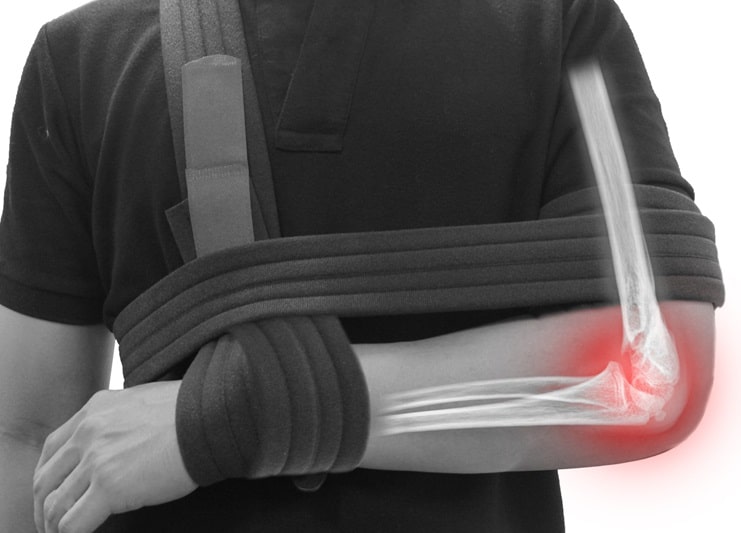An elbow contracture refers to a condition where there is a loss of motion in the elbow joint due to the tightening or shortening of the soft tissues surrounding the joint, such as muscles, tendons, and ligaments. This can result in difficulty fully extending or flexing the elbow. It can be caused by various factors including injury, prolonged immobility (such as being in a cast for an extended period), arthritis, or scar tissue formation after surgery. Treatment may involve physical therapy, stretching exercises, and in some cases, surgical intervention.


If you are experiencing elbow pain, stiffness, or swelling, please contact us at Fair Oaks Orthopedics. Dr. Stephen W. Pournaras and our professional medical staff have an excellent knowledge of the complex network of blood vessels, nerves, muscles, ligaments, tendons, and bones that make up your arm and elbow. We can help you now by simply contacting us today.

Elbow contracture release surgery is a procedure aimed at restoring movement and function to the elbow joint by surgically releasing tight or shortened soft tissues that are causing the contracture. During the surgery, the surgeon may remove scar tissue, release tight ligaments or tendons, and sometimes perform a procedure called capsular release, which involves cutting through the joint capsule to increase the range of motion.
The specific approach and techniques used in elbow contracture release surgery can vary depending on the underlying cause of the contracture and the severity of the condition.
What Does “Contracture of Elbow” Mean?
A “contracture of the elbow” refers to a condition where the range of motion of the elbow joint is significantly limited due to the tightening or shortening of the soft tissues surrounding the joint. This tightening can involve muscles, tendons, ligaments, and joint capsules. As a result, you may have difficulty fully extending or flexing your elbow.
This debilitating condition can be caused by several things, including repetitive motions, prolonged immobilization, disease, burns, or other injuries.
Elbow contractures can result from prior injuries called posttraumatic elbow stiffness or post-traumatic flexion contracture. In some cases, the exact cause is condition is unknown.
Regardless of the underlying cause, the end result is the same: a restriction in the normal movement of the elbow joint.
This limitation in motion can impact your daily activities and may cause discomfort or pain. Treatment for an elbow contracture involves physical therapy, stretching exercises, splinting, and sometimes surgury to release the tight tissues and restore movement to the joint.
There are several factors can contribute to the development of elbow contracture, including:
Injury: Trauma to the elbow, such as fractures or dislocations, can lead to the formation of scar tissue and subsequent contracture.
Lack of movement: Being immobilized in a cast or splint for an extended period can cause the soft tissues around the elbow joint to become tight and stiff.
Arthritis: Conditions like rheumatoid arthritis or osteoarthritis can lead to inflammation and damage to the tissues within the elbow joint, resulting in contracture.
Past Surgery: In some cases, surgical procedures performed on the elbow can lead to scar tissue formation and contracture.
Elbow contracture can significantly impact daily activities and quality of life, as it limits the ability to perform tasks that require a full range of motion in your arm.
Treatment for elbow contracture may include physical therapy, stretching exercises, splinting, and in some cases, surgery to release the tight tissues and restore movement to the joint.
Early diagnosis and intervention are essential for the best outcomes in managing your elbow contracture.
The treatment of elbow contractures depend on the underlying cause, the severity of the contracture, and your overall health and functional goals.
Physical Therapy and Stretching Exercises: Physical therapy plays a crucial role in the management of elbow contractures. Our physical therapists can develop a personalized exercise program to stretch and strengthen the muscles surrounding the elbow joint. Passive stretching exercises, where the therapist will gently move the joint through its range of motion, can help loosen tight tissues.
Splinting: This can be used to help maintain the corrected position of the elbow joint and prevent further contracture. A custom splint or brace may be prescribed to keep the elbow in an extended or flexed position, depending on the specific needs of the individual.
Modalities: Such as heat, cold, ultrasound, or electrical stimulation may be used to help relax muscles, reduce pain, and improve tissue flexibility.
Joint Mobilization Techniques: Manual therapy techniques performed by a skilled therapist, such as joint mobilization or manipulation, can help improve joint mobility and reduce stiffness.
Surgery: In cases where non-surgical treatments do not improve the contracture or when the contracture is severe, surgery may be necessary. Surgical procedures such as contracture release, where tight or scarred tissues are surgically released, may be performed to restore mobility to the elbow joint.
BOTOX – Botulinum Toxin Injections: In cases where muscle spasticity contributes to the contracture, injections of botulinum toxin (Botox) may be used to relax the affected muscles and improve joint mobility temporarily.
Occupational Therapy: Occupational therapy focuses on improving functional abilities and may include activities of daily living (ADL) training, adaptive equipment recommendations, and ergonomic assessments to optimize function and independence.
Medications: In some cases, medications such as nonsteroidal anti-inflammatory drugs (NSAIDs) or corticosteroid injections may be used to reduce pain and inflammation associated with elbow contractures.
Elbow contracture release is a surgical procedure performed to restore movement and function to the elbow joint by releasing tight or shortened soft tissues that are causing the contracture.
This surgery’s goal is to to improve the range of motion in your elbow, allowing for better movement and extension.
During the procedure, Dr. Pournaras may remove scar tissue, release tight ligaments or tendons, and sometimes perform a capsular release, which involves cutting through the joint capsule to increase flexibility. The specific techniques used depend on the underlying cause and severity of the contracture.
Elbow contracture release surgery is typically recommended for patients who have tried non-surgical treatments such as physical therapy without success and who continue to experience limited motion and functional impairment in the elbow joint. After surgery, patients usually undergo a period of rehabilitation and physical therapy to optimize recovery and regain strength and flexibility in the elbow.
Make Your Appointment Today
Fair Oaks Ortho – Fairfax,VA


